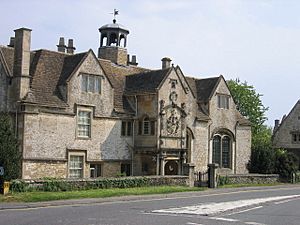Hungerford Almshouses facts for kids
Quick facts for kids Hungerford Almshouses |
|
|---|---|
 |
|
| Location | Pound Pill, Corsham, Wiltshire, England |
| Built | 1668 |
| Built for | Lady Margaret Hungerford |
|
Listed Building – Grade I
|
|
| Designated | 1 August 1986 |
| Reference no. | 315361 |
| Lua error in Module:Location_map at line 420: attempt to index field 'wikibase' (a nil value). | |
The Hungerford Almshouses are historic buildings located in Corsham, a town in Wiltshire, England. These special homes were built way back in 1668. They were created by Lady Margaret Hungerford from Corsham Court to help people in need. Today, the almshouses are recognized as a Grade I listed building, which means they are very important and protected.
Contents
What Are Almshouses?
Almshouses are a type of charitable housing. They provide homes for people who need support, often those who are elderly or poor. The Hungerford Almshouses were set up to offer a safe place to live for six, and later eight, people. They also provided education for ten children. This was a big help for the community in Corsham centuries ago.
Where Are They Located?
The almshouses are found on the eastern side of Corsham town. They are close to the south entrance of Corsham Court. This location made them easy to access for the people they were meant to help.
Design and Features
The Hungerford Almshouses have a unique L-shaped design. The building has several interesting features that show how it was built in the 17th century.
Homes for Residents
Along the north-east side of the building, there are six houses. These were originally for single women. Each house has a pointed roof section called a gable. They also have mullioned windows, which means the windows are divided by stone or wooden bars.
Special Carvings
In the middle of the building, you can see a detailed carving. This carving shows the Hungerford family's coat of arms. It's made in a style called Baroque, which is known for being very decorative and grand.
Schoolroom and Chapel
The west side of the building holds the warden's house. The warden was like a manager for the almshouses. This side also has a room that was used as both a schoolroom and a chapel. A chapel is a small church or place of worship. There's also a tall porch on this side, which is also very decorated.
Who Was Lady Margaret Hungerford?
Lady Margaret Hungerford was the person who had these almshouses built. She was a very important woman in her time.
Her Family Background
Margaret Hungerford was the daughter of William Holliday. He was a very rich merchant and an alderman in London. An alderman was a senior member of a city council. Margaret was also the widow of Sir Edward Hungerford.
Later History
Over the years, the Hungerford Almshouses continued to serve their purpose. They also had some notable people involved in their history.
Edward Hasted's Role
In 1802, a man named Edward Hasted became the Master of The Hungerford Almshouses. He was given this role by his friend William Bouverie. William Bouverie had become the Earl of Radnor in 1765. Edward Hasted stayed as the Master until he passed away in 1812.
Visiting the Almshouses Today
Today, the Hungerford Almshouses are still standing and are known by a few different names. They are sometimes called the Lady Margaret Hungerford Almshouses & Schoolroom or the Corsham Almshouses & 17th Century Schoolroom. These historic buildings are now open to visitors. People can explore them and learn about their long history and how they helped the community centuries ago.

